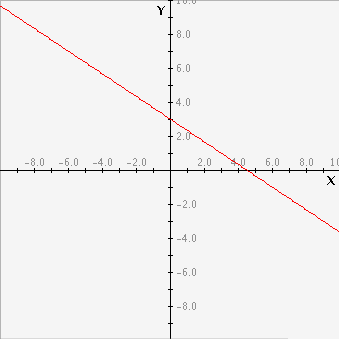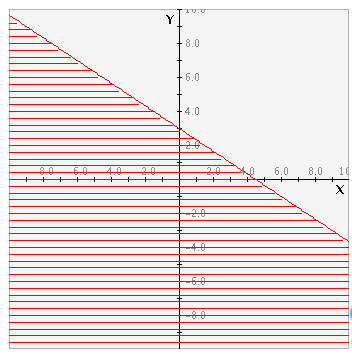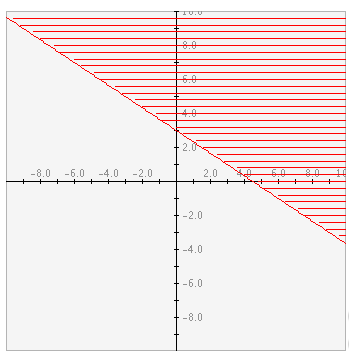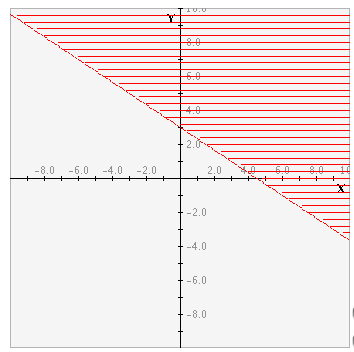Student: I know how to graph linear functions , but I'm confused about graphing inequalities. What are the differences between graphing linear functions and graphing inequalities?
Mentor: Well, there are several differences. A linear inequality looks very similar to a linear function if it is less than, less than or equal, greater than, or greater than or equal to a number. Therefore, there is not one value for y that corresponds to a single x value, but rather many possible values for y that correspond to a single x that satisfy the inequality.
Student: How do we find which values can exist for x and y?
Mentor: Lets look at the inequality 2x+3y < 9. To find the maximum values of x and y in this inequality, what could we do?
Student: Well, since 2x+3y is less than or equal to 9, the largest values of x and y would exist when these values equal 9.
Mentor: That is right! So lets graph the maximum line of this inequality by finding the graph of the line if x and y were as large as they could be. In other words, lets find the graph of the line if it were the function were 2x+3y = 9.
Student: That is a linear function ; I know how to graph those! First I solve for y so that I have the function in y=mx+b form. I will get y on one side so that the function is 3y = -2x + 9 and then I will get y by itself by dividing both sides by 3. The final equation would be y=-2/3x + 3.
Mentor: Now why is putting the function in that form helpful?
Student: Because it tells me the slope and y-intercept! The slope is the number before the x, which tells me how steep the line is and the number by itself tells me where the line intersects the y axis.
Mentor: Right, so the slope of the line is -2/3 and the y-intercept is 3. Lets take a look at that line on the graph using the inequality applet.

Student: I can see the line crossing the y-axis at exactly 3! Also, the slope looks like it is (-2/3) because for every two units down in the y direction, it changes three in the positive x direction. This is the graph of the function 2x+3y = 9! Now, we want to graph the function 2x+3y < 9, so what do we do next?
Mentor: Since this is an inequality, many values for x and y can make the function true. For example, 2x+3y = 8 or 2x+3y = 2.
Student: Or even 2x+3y = -10 or 2x+3y = 0.05.
Mentor: Exactly! There is an endless amount of functions that can exist within this inequality. Instead of graphing each possible function (which would be an impossible task) we shade in all of the area below the line 2x+3y=9. The shading will show that all functions below the line satisfy the inequality. The functions that we mentioned, 2x+3y=8, 2x+3y=2, 2x+3y=-10, and 2x+3y=0.05 (as well as many others) exist in the shaded area of the graph. Let's look at it on a graph.

Student: Wow, so every linear function that is on that line or below that line is part of the function 2x+3y < 9.
Student: OK, so what if the function had been 2x+3y >= 9, would that mean that all of the area above the line 2x+3y=9 would be shaded?
Mentor: That is exactly right. If 2x+3y >= 9, then that means that 2x+3y could equal values such as 10, 20.7, and even 1,000. All of those functions on a graph would be above the line 2x+3y=9. Here is a graph of the function 2x+3y >= 9:

Student: OK, that makes sense! What if the function were just 2x+3y>9? In that function 2x+3y is not equal to 9 so the function 2x+3y=9 could not be part of the graph. How would you graph it?
Mentor: Great question! Actually, we would still graph a line for 2x+3y=9, but instead of a solid line, we represent it with a dashed line. In this case the dashed line represents the idea that 2x+3y=9 does not satisfy the function 2x+3y>9, but any value above the line does. It would look like this:

Student: This graph looks very similar to the graph 2x+3y >= 9. I can't really see the dashed lines.
Mentor: Since this graph is very large you cannot see much detail. If you were to set the window to a smaller area you would be able to see the dashed lines better. Now, knowing that you would use a dashed line and shade above the line 2x+3y=9 when you have the inequality 2x+3y > 9, what do you think you would do for the inequality 2x+3y < 9.
Student: I would use a dashed line when graphing 2x+3y=9 since the function 2x+3y is less than, but not equal, to 9. Also, I would shade below that dashed line since it is a less than inequality.
Mentor: Great job! You are ready to experiment with the Inequality activity.